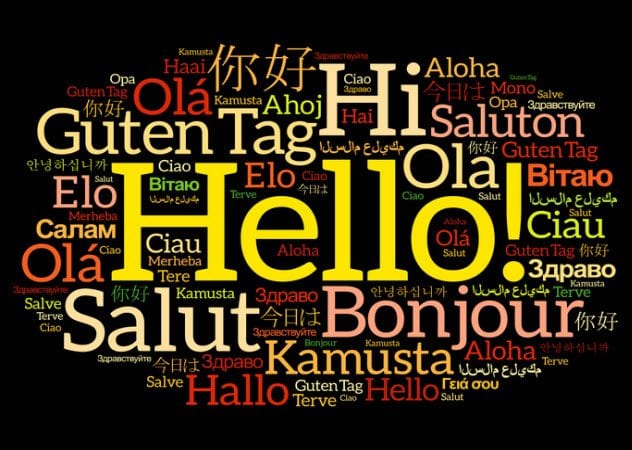 Technology
Technology  Technology
Technology  Humans
Humans 10 Everyday Human Behaviors That Are Actually Survival Instincts
 Animals
Animals 10 Animals That Humiliated and Harmed Historical Leaders
 History
History 10 Most Influential Protests in Modern History
 Creepy
Creepy 10 More Representations of Death from Myth, Legend, and Folktale
 Technology
Technology 10 Scientific Breakthroughs of 2025 That’ll Change Everything
 Our World
Our World 10 Ways Icelandic Culture Makes Other Countries Look Boring
 Misconceptions
Misconceptions 10 Common Misconceptions About the Victorian Era
 Mysteries
Mysteries 10 Strange Unexplained Mysteries of 2025
 Miscellaneous
Miscellaneous 10 of History’s Most Bell-Ringing Finishing Moves
 Technology
Technology Top 10 Everyday Tech Buzzwords That Hide a Darker Past
 Humans
Humans 10 Everyday Human Behaviors That Are Actually Survival Instincts
 Animals
Animals 10 Animals That Humiliated and Harmed Historical Leaders
Who's Behind Listverse?

Jamie Frater
Head Editor
Jamie founded Listverse due to an insatiable desire to share fascinating, obscure, and bizarre facts. He has been a guest speaker on numerous national radio and television stations and is a five time published author.
More About Us History
History 10 Most Influential Protests in Modern History
 Creepy
Creepy 10 More Representations of Death from Myth, Legend, and Folktale
 Technology
Technology 10 Scientific Breakthroughs of 2025 That’ll Change Everything
 Our World
Our World 10 Ways Icelandic Culture Makes Other Countries Look Boring
 Misconceptions
Misconceptions 10 Common Misconceptions About the Victorian Era
 Mysteries
Mysteries 10 Strange Unexplained Mysteries of 2025
 Miscellaneous
Miscellaneous 10 of History’s Most Bell-Ringing Finishing Moves
10 Linguistics Myths And Misconceptions
Compared to most subjects, linguistics can seem pretty democratic. Fields like physics, math, and history deal in the abstract, in otherwise unobservable things or events.
Linguistics, on the other hand, deals with something that we all have an intimate knowledge of. However, this means we tend to hold a lot of assumptions or even outright misconceptions. These can color the way we approach language as a scientific subject.
10 Inuit Words For ‘Snow’ And A Massachusetts Fire Inspector

Linguistic relativity is a theory sometimes called the “Sapir–Whorf hypothesis.” It says that a language can influence how its speakers see the world. For those who like some spice with their science, it also comes in the strong version of “linguistic determinism.”
We often hear about it in reference to the languages of the various indigenous North Americans. We are often told that Inuit people understand snow differently than we do because they have a far bigger snow-related vocabulary.
At least, this is the idea that Benjamin Lee Whorf—a fire safety inspector and part-time language scholar—popularized in his 1940 article “Science and Linguistics.” This idea took the world by storm, even causing the coinage of “snowclone” in response.
However, it turns out that this claim is a little dubious. Depending on what we call a “word,” the Inuit languages seem to have a similar number of snow-related word roots as our languages do.
Furthermore, Whorf’s piece seems to make up several Inuit words. Otherwise, he really did not understand the source he was using. In fact, it seems that a lot of evidence Whorf used to prove his linguistic relativity is equivocal or even made up. These days, the “strong” version of the theory has been all but discarded.
9 English (Or French, Russian, Tamil, Etc.) Has The World’s Richest Vocabulary

Another myth that we’ve all heard in class is that the English vocabulary is the richest in the world, that it has more words than any other language. The reason for this, we are told, is that English is a “mixed language,” with vocabulary from German, French, and Latin.
Of course, the number of words depends on where you look. Webster’s, for example, counts 475,000. The Global Language Monitor somehow managed to document English’s “millionth word.” They even gave June 10, 2009, 10:22 AM GMT, as a date! Unsurprisingly, other languages make the same claim.
The problem is that we do not know what a “word” is. In English, we might define it as whatever is surrounded by space in writing. However, we do not speak with spaces, we would have to include contractions like “can’t” as words, and we cannot apply this idea to many other languages.
The Inuit languages, for example, use inflections to make what they understand as single words that convey a lot of information. This also happens somewhat with German “compound nouns.” An infamous example of such a compound noun (without the hyphen) is donaudampfschiffahrtselektrizitaten-hauptbetriebswerkbauunterbeamtengesellschaft, which refers to a suborganization of the First Danube Steamboat Shipping Company.
8 Children Learn Languages More Easily Than Adults

Another myth, and one that often disheartens adults, is that children are vastly superior at learning languages. This idea is a specious one at best. Children seem to go from a state of ignorance to being wonderfully eloquent.
This seemingly miraculous growth is fascinating and rather puzzling. However, it often leads to adults believing that learning a language would be too difficult after childhood. This is simply not the case.
First, it takes a lot of effort for a baby to learn how to speak. It is a process that lasts until around six or seven and, even then, a few grammar points can prove tricky.
However, it is clear that adults learn new languages far more quickly than infants. Some Internet polyglots can apparently do it in three months. So if you are a budding language student looking to pick up Italian, Czech, or Xhosa, go for it. You have already gone through the hard bit of learning your first tongue.
7 A Language Is A Dialect With An Army And Navy

Most of us would be happy to accept the last few myths as false. But surely we all know what languages, dialects, and accents are? A language is a way of speaking and writing, a dialect is a weird variety of a language, and an accent is what you sound like. Well, not quite. At least, not to linguists.
Typically, we think of “Standard English” as a language and variations such as Southern English and African-American Vernacular English (AAVE or “Ebonics”) as dialects. But a linguist would call Standard English a dialect, too.
The difference between Standard English and nonstandard dialects is “prestige.” By definition, a standard has the “prestige” in society. For example, AAVE is not an inferior dialect of “normal” English, just a “non-prestige” variety.
“Accent” also confuses people. Our phonological peculiarities are often called accents, but these can also fall under the already-cloudy realm of dialects. Even more confusingly, “accent” is sometimes reserved to talk about the features of a non-native speaker’s speech.
There is some truth to the old Yiddish adage, a shprakh iz a dialekt mit an armey un flot (“a language is a dialect with an army and navy”). It neatly describes how “prestige” dialects come to be seen as distinct “languages” as opposed to mere “dialects.” Yiddish is itself an example of such a “dialect,” at times being subordinated to German.
6 Some Languages Are Simpler Than Others

The topic of language complexity is a controversial one. Many people assume that some languages (i.e., their own) are more complex than others. From a linguist’s point of view, however, it is difficult to determine how complicated a language is.
The consensus is the “compensation hypothesis.” David Crystal describes it thus: “All languages have a complex grammar. There may be relative simplicity in one respect (e.g., no word endings), but there seems always to be relative complexity in another (e.g., word position).”
The issue with this idea arises when people combine this view with linguistic relativity. Thinking of a language as simplistic can be problematic when you also think that language limits thought.
An example of this combination is the treatment of Scots—a minority language spoken in Scotland. During the early 20th century, its usage was forbidden in education and it was described as “unsuitable” for teaching, despite many children speaking it natively.
5 Sign Languages Are Not Complete Languages

Sign languages face the same misconceptions as above. Many people think that sign languages are mimed versions of spoken language. In 2011, the Italian Parliament tried to rename Italian Sign Language (Lingua dei Segni Italiana) as Language of Mime and Gesture (Linguaggio Mimico Gestuale), leading to an uproar in the Italian deaf community.
The fact is, sign languages are complete and expressive languages. For example, the grammar of American Sign Language (ASL) is distinct from English grammar. It has topicalization, which is seen in languages like Japanese and Chinese.
This leads to many different word orders which do not exist in English. ASL even has a complex conjugation system for its verbs with agreement and tense. Sign languages can borrow words from other languages—both signed and spoken—using finger spelling in the case of spoken borrowings.
4 Animal Language
There are many way in which animals communicate—birdsong, pheromones, and waggle dances. Of course, there are also many misconceptions. The most common is that these ways of communicating are linguistic, that they are primitive forms of human language. But this terminology can lead to some confusion. So we need to consider what we mean by “language.”
Two criteria tend to crop up when we try to define language. One is discreteness. This is the idea that a language has to be made of indivisible elements that can be put together.
This element is the morpheme, which is the smallest unit of meaning in a word. “Car,” for example, is a morpheme, as is “water.” You cannot split up these words. On the other hand, “typewriter” has three morphemes: “type” + “write” + “er.” “Undesirability” has four: “un” + “desire” + “able” + “ity.”
The other criterion we often see is productivity or creativity. According to linguist Noam Chomsky, this is how speakers take the discrete bits of their language and put them together to produce an indefinite number of phrases that other members of a speech community can readily understand.
Basically, productivity is the ability to make a sentence of indefinite length that anyone who shares your language can understand. The combination of these two ideas is called “digital infinity.”
Digital infinity makes humans distinct from animals. As far as we know, animals cannot grasp morphemes at all and certainly cannot put them together. In fact, a one-year-old’s language is already far more sophisticated than that of any animal.
3 ‘Caught It,’ Not ‘Catched It’

One of the most prevalent misconceptions concerns how children learn to speak. Those of us who are parents, older siblings, or aunts and uncles may have even experienced this one. We think that when we raise babies, we need to teach them how to talk. This means engaging in word games, asking for the names of things, and, of course, correcting errors like the one in the entry title.
This, however, is the misconception. A baby comes up with the rules of his or her language simply by hearing others speak. In fact, the problem of errors like “catched” or “foots” is a good example of kids’ ability to generalize rules they hear. You might argue, “Well, those are errors that we need to correct.”
However, young kids tend to ignore or misunderstand these corrections and will organically pick up the right forms as they age. A famous experiment by Jean Berko Gleason called the “Wug Test” demonstrated kids’ abilities to make generalizations by asking them to form plurals and past tenses using made-up words with colorful illustrations.
How children manage to accomplish the feat is still largely unknown. One of the current theories is “universal grammar”—the idea that humans have an internalized set of grammatical rules that undergo transformations to become normal phrases. This theory is not without controversy, however, and there is no consensus yet.
2 Text Speech Is Ruining Kids’ English

To those of us who have young people on Facebook, this is no misconception. Perhaps you struggle with telling your “LOLs” from your “LMAOs.” It is self-evident that kids these days just do not talk or write as well as they used to. Well, not quite.
Without getting into the idea of mistakes, there is evidence that shows kids are doing just as well as they used to, linguistically speaking. In fact, there may be some reason to think they are doing better.
First, the notion that today’s kids cannot communicate as well as kids from previous generations is definitely not true. We need only observe a group of kids to know that they are perfectly capable of mutual comprehension.
Fine, you would likely agree, but can they really communicate with those of us unfamiliar with their “youthemisms”? Well, research shows that kids are actually quite good at using the appropriate register when needed. Surprisingly, the same studies also show that kids actually get better at writing the more they text.
A researcher involved says that the omission of punctuation and capital letters correlates with the development of spelling, grammar, and punctuation skills. The researchers argue that the tendency to abbreviate words means that young people tend to have a better understanding of spelling and how it corresponds to speech.
Perhaps this research should not be surprising. David Crystal points out that kids are now engaged with reading and writing on a level we have never seen before and it is because of their access to phones and computers. Kids are writing more than ever, and db8ing it seems silly.
1 I Think You Mean ‘Figuratively’

Here we are, then, at what may be the most pervasive of all language myths. This myth is that of the pedant, the grammar Nazi, which is called “linguistic prescriptivism.”
Prescriptivism is the idea that “grammar” is a list of a language’s dos and don’ts—such as not misusing “literally,” not splitting infinitives, and not ending sentences with prepositions. The fact is, the reasoning of the pedant is wrong on two levels.
The first is that the vast majority of traditional grammar rules were imported from other languages (notably French and Latin) or were otherwise made up to suit someone’s tastes. The split infinitive rule, for example, comes from an 18th-century desire to make English more like Latin.
Infinitives are one word in Latin, but they are two in English. For example, habere in Latin is “to have” in English, amare is “to like,” etc. In English, it is possible to put a word—usually an adverb—in between the “to” and the verb.
Star Trek gives us the perfect example: “To boldly go where no man has gone before.” A prescriptivist, in keeping with a more Latinate style, would correct that to: “To go boldly where no man has gone before.” It sounds weird, do you not think?
But the second reason that prescriptivism is wrong is linguistic. The fact is that there is no clear-cut definition of “error.” One could argue that language is about convention, and thus, usages that differ from the convention are erroneous.
The problem, though, is that language is a lot more diverse than we think. You need only compare the idiom of someone from Australia to that of someone from the Deep South to see this. A prescriptivist could put this down to dialectical differences and correct himself by saying “dialects have conventions.”
However, linguists also recognize “idiolects”—the features unique to an individual speaker. The fact is, prescriptivists have no authority on which to base their claims, other than personal tastes and the conventions that they have internalized. Linguists prefer to take a “descriptive” view of language.
Billy is a student of Spanish and Arabic, and he loves all things linguistic.








